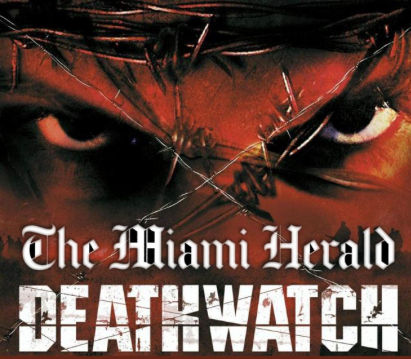 |
As this image from video shows, TV crews were on the scene
within minutes of the mass shooting at The Spot nightclub, but
it took the Miami Herald more than 8 hours to dispatch a reporter
and photographer.
(Click image to enlarge.) |
I'm 100% certain that if you asked anyone who works at the
Miami Herald if the paper is guilty of racism in its coverage of some communities, the answer would be a unanimous "absolutely not."
But there's mounting evidence that suggests otherwise.
This morning at about 1 a.m., an unknown gunman - or gunmen - opened fire into a crowd of people at a nightclub in Liberty City.
One witness thinks he heard as many as 100 shots.
At least 15 people were injured. Some of those hit by bullets were children. Why children were at a nightclub at one o'clock in the morning is something that investigators will hopefully be looking into in the days ahead.
From
CBS Miami:
The incident took place at N.W. 7th avenue and 64th street.
When Miami police and rescue crews arrived at a club called The Spot around 1 a.m., they said they found chaos among the large throng of adults and teenagers gathered there. Rescuers found wounded people inside and outside the club, some too hurt to flee, Miami Fire Rescue Capt. Ignatius Carroll said.
He told The Associated Press that the first emergency crews arriving on the scene were warned to use caution “because there was still active shooting taking place in the area.”
[...]
Authorities said there were many young people at the site. At least three of those hurt were transferred to a pediatric unit.
“What was very surprising to the responders was that these were kids that were out at 1 o’clock in the morning in a club and this type of violence took place where a bunch of kids were gathering … it’s very disturbing to see that,” Carroll said.
But despite the seriousness and magnitude of the crime, a full seven and a half hours passed before the
Miami Herald posted anything on the mayhem that had taken place.
A
Herald reporter and photographer were finally sent to to the scene, arriving more than 8 hours after the shooting.
Last July 4 it took the
Herald more than 10 hours to post anything on a
holiday weekend boating crash that left four people dead. All because no one knew about the accident until the morning crew arrived.
I'm sure those in charge at the
Herald would laugh if anyone suggested they send a reporter to cover a city commission meeting 8 hours after it started....or have a photographer arrive at a Dolphins game well into the 4th quarter. But for some unknown reason, those same bosses think nothing of waiting 7, 8, or 9 hours after a breaking news event has occurred before sending someone to cover it.
The
Herald's complete lack of urgency in its response to last night's shooting shows that in the months since the bungled coverage of the boating crash, no one at the paper has shown any kind of leadership by making changes to the way major overnight breaking news is handled.
________
January 8, 2013: Checking up on the Miami Herald's "24/7 Information Specialists"
________
Several
Herald insiders told me this morning that the paper has no coherent plan to cover major news that occurs overnight. "It's hit and miss," said one staffer who added, "but mostly miss."
But aside from no leadership, what explains the
Herald's lethargic response to news that occurs in some Miami neighborhoods? Is it racism, or incompetence, or a little bit of both?
Imagine that the circumstances of last night's shooting were exactly the same, except that it took place at a party at an upscale Coral Gables restaurant instead of a sketchy nightclub on N.W. 7th Avenue.
Does anyone think for one second that the
Herald would wait 7 or 8 hours before sending a reporter and photographer to cover the story of someone firing 100 shots at diners inside Christy's Restaurant?
Last March I
reported that the
Herald had virtually given up on covering any kind of violent crime in one northwest Miami neighborhood.
It appears that those in charge plan to keep it that way.
By the way, the story of the club shooting was pushed aside on the
Herald's website this afternoon for coverage of your beloved Miami Dolphins.
Because there's nothing more important than a football game.





































